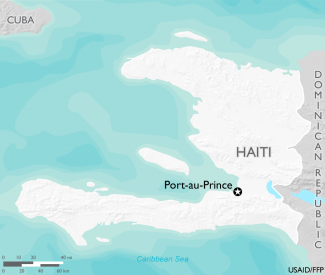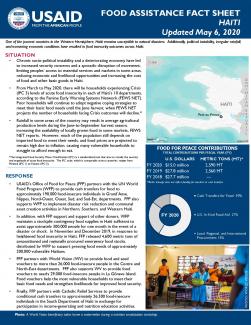May 6, 2020
One of the poorest countries in the Western Hemisphere, Haiti remains susceptible to natural disasters. Additionally, political instability, irregular rainfall, and worsening economic conditions have resulted in food insecurity outcomes across Haiti.
Situation
- Chronic socio-political instability and a deteriorating economy have led to increased security concerns and a sporadic disruption of movement, limiting peoples’ access to essential services and markets in some areas, reducing economic and livelihood opportunities and increasing the cost of food and other basic goods in Haiti.
- From March to May 2020, there will be households experiencing Crisis (IPC 3) levels of acute food insecurity in each of Haiti’s 10 departments, according to the Famine Early Warning Systems Network (FEWS NET). Poor households will continue to adopt negative coping strategies to meet their basic food needs until the June harvest, when FEWS NET projects the number of households facing Crisis outcomes will decline.*
- Rainfall in some areas of the country may result in average agricultural production levels during the June-to-September harvest season, increasing the availability of locally grown food in some markets, FEWS NET reports. However, much of the population still depends on imported food to meet their needs, and food prices are projected to remain high due to inflation, causing many vulnerable households to struggle to afford enough to eat.
* The Integrated Phase Classification (IPC) is a standardized tool that aims to classify the severity and magnitude of food insecurity. The IPC scale, which is comparable across countries, ranges from Minimal (IPC 1) to Famine (IPC 5).
Response
- USAID’s Office of Food for Peace (FFP) partners with the UN World Food Program (WFP) to provide cash transfers for food to approximately 190,000 food-insecure individuals in Grand’Anse, Nippes, Nord-Ouest, Ouest, Sud, and Sud-Est, departments. FFP also supports WFP to implement disaster risk reduction and communal asset creation activities in Northern, Southern, and Western Haiti.
- In addition, with FFP support and support of other donors, WFP maintains a stockpile contingency food supplies in Haiti sufficient to assist approximately 300,000 people for one month in the event of a disaster or shock. In November and December 2019, in response to heightened food insecurity in Haiti, FFP released 4,600 metric tons of prepositioned and regionally procured emergency food stocks, distributed by WFP to support pressing food needs of approximately 200,000 vulnerable Haitians.
- FFP partners with World Vision (WV) to provide food and seed vouchers to more than 26,000 food-insecure people in the Centre and North-East departments. FFP also supports WV to provide food vouchers to nearly 29,000 food-insecure people in La Gônave Island. Food vouchers help the most vulnerable households to meet their basic food needs and strengthen livelihoods for improved food security.
- Finally, FFP partners with Catholic Relief Services to provide conditional cash transfers to approximately 26,500 food-insecure individuals in the South Department of Haiti in exchange for participation in income-generating and nutrition education activities.
Food for Peace Contributions
Total Contributions:
| U.S. Dollars | Metric Tons | |
|---|---|---|
| Fiscal Year 2020 | $15.0 million | 2,590 MT |
| Fiscal Year 2019 | $27.8 million | 2,560 MT |
| Fiscal Year 2018 | $27.7 million | ---- |
* Metric tonnage does not reflect funding for vouchers or cash transfers.
Country Specific Guidance
Related Resources


